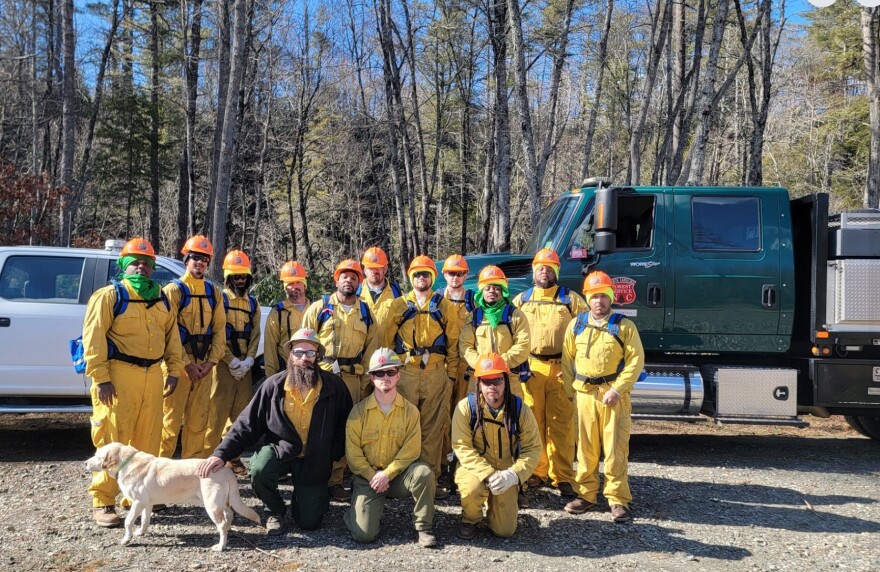Building, rehabilitating, instructing, developing, growing, employing. Those are the promises made by the BRIDGE program, which trains incarcerated young men to fight fires, among other skills.
But does it hold true to those promises? For Burt Torrain, the answer is complicated. Torrain participated in BRIDGE in 1991. Locked away on drug charges, he said the program gave him an opportunity to get out of his cell.
“I learned about forest fires, how you can control it and do different things,” Torrain said. “I enjoyed it.”
Torrain now lives in Burlington, North Carolina. He says he enjoyed the program. He uses the skills he learned in his day job as a bricklayer and teaches them to his grandkids. He’s kept in touch with some of his buddies.
“We laugh at the stuff we done,” Torrain said. “A lot of us come from some of the poor, poor neighborhoods, and if we, if we never did get locked up, we would have never had that opportunity."
At the same time, Torrain is clear about the program's shortcomings. The inmates were doing dangerous work, he said, and should have been paid more. In 1991, he was paid $1 a day. BRIDGE members now get paid 62.5 cents an hour. And while the program promises to rehabilitate and employ — history and data suggest a more complicated picture.
The BRIDGE program evolved out of the 1985 wildfire season. That was when the state called up 75 untrained incarcerated men to fight a fire in Burke County. Sociology professor Dr. Carlee Purdum studies incarcerated people and disasters.
“It was an informal decision that there was a fire, a wildfire that happened,” Purdum said. “Incarcerated people were pulled from the prisons to help respond. There hadn't been a formal program before.”
The N.C. Forest Service and Department of Corrections claim on their websites that just 12% of young men who go through the program will return to prison, compared to the national average of 35% But, a 2010 study done by the state’s office of research and planning found that actually, 39% of participants returned to prison — the most recent data available. In the lines following that stat, the state says that there is no change in returns to prison due to participation in the program.
The Department of Corrections did not respond to an email seeking comment, and the Forest Service did not make any program leaders available to speak.
“These programs are theoretically saying they're making our community safer by providing rehabilitative programs,” Purdum said. “What happens when they are shown that that's not true?”

BRIDGE does not track post release employment. Most participants aren’t in the program long enough to get enough experience to gain immediate employment in related fields. The average participant spends 170 days in the program. A recent job posting for an assistant ranger with the forest service required two years of experience. And, of course, they’ll be applying for jobs with a criminal record, always a hurdle.
“Why is it continued? It's because these fires, these disasters, are very expensive, and incarcerated labor is low cost,” Purdum said.
The U.S. saw 115 weather and climate disasters with damages exceeding $1 billion in the past 5 years, and those are growing in number as the planet warms. BRDIGE has saved the state of North Carolina $36 million since its inception, according to the forest service. BRIDGE participants are paid, again, 62.5 cents an hour. An emergency pickup firefighter makes $15.53 an hour.
At least 14 other states, including California, Georgia and Washington use incarcerated firefighters to help fight wildfires.
The North Carolina Forest Service is underfunded and understaffed. In April, they requested $28 million for overtime pay, salary increases and the creation of a new wildfire crew. They got $15 million. In the past five years, they’ve had 100 vacant positions.
"It's an unfair situation where they're [firefighters] having to make that decision and being framed as the bad guys as well,” Purdum said. “Because if we just fully funded what we know needs to be fully funded, then we wouldn't have this, we wouldn’t have to talk about how programs like this exploit people.”
“Offender labor” is written into the state’s emergency operations plan. A 2010 forest service report wrote that "Crews provided by the BRIDGE Program are a critical resource which can’t be replaced in a cost-effective way … Without a resource such as BRIDGE, wildfires will become larger, cause more damage, and endanger more lives.”
Wildfires are already getting larger. Western North Carolina saw some of its biggest wildfires this past spring, due mostly Hurricane Helene debris. Philip Jackson is with the forest service. WFAE spoke with him earlier this summer about the growth of fire season.
“What happened in the springtime in western North Carolina is probably going to be the new normal for the next decade,” Jackson said.
In that new normal, with more heat waves and wildfires, the state will keep relying in part on incarcerated people, making pennies an hour, for protection. Torrain said former BRIDGE participants could help, if given the chance.
“If ex-prisoners who've been out want to do it and get the opportunity to go back in and do it again, on a level of being free, of doing it and making good money, that would be something good,” Torrain said.



